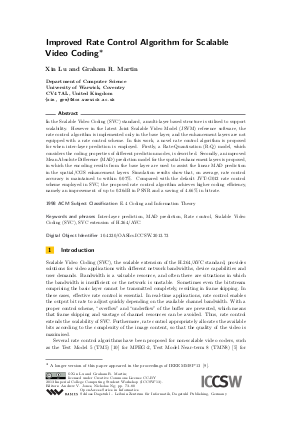Improved Rate Control Algorithm for Scalable Video Coding
Authors Xin Lu, Graham R. Martin
-
Part of:
Volume:
2013 Imperial College Computing Student Workshop (ICCSW 2013)
Part of: Series: Open Access Series in Informatics (OASIcs) - License:
 Creative Commons Attribution 3.0 Unported license
Creative Commons Attribution 3.0 Unported license
- Publication Date: 2013-10-14
File

PDF
OASIcs.ICCSW.2013.73.pdf
- Filesize: 1.67 MB
- 8 pages
Document Identifiers
Subject Classification
Keywords
- Inter-layer prediction
- MAD prediction
- Rate control
- Scalable Video Coding (SVC)
- SVC extension of H.264/AVC
Metrics
- Access Statistics
-
Total Accesses (updated on a weekly basis)
0PDF Downloads0Metadata Views
Abstract
In the Scalable Video Coding (SVC) standard, a multi-layer based structure is utilised to support scalability. However in the latest Joint Scalable Video Model (JSVM) reference software, the rate control algorithm is implemented only in the base layer, and the enhancement layers are not equipped with a rate control scheme. In this work, a novel rate control algorithm is proposed for when inter-layer prediction is employed. Firstly, a Rate-Quantisation (R-Q) model, which considers the coding properties of different prediction modes, is described. Secondly, an improved Mean Absolute Difference (MAD) prediction model for the spatial enhancement layers is proposed, in which the encoding results from the base layer are used to assist the linear MAD prediction in the spatial/CGS enhancement layers. Simulation results show that, on average, rate control accuracy is maintained to within 0.07%. Compared with the default JVT-G012 rate control scheme employed in SVC, the proposed rate control algorithm achieves higher coding efficiency, namely an improvement of up to 0.26dB in PSNR and a saving of 4.66% in bitrate.
Cite As Get BibTex
Xin Lu and Graham R. Martin. Improved Rate Control Algorithm for Scalable Video Coding. In 2013 Imperial College Computing Student Workshop. Open Access Series in Informatics (OASIcs), Volume 35, pp. 73-80, Schloss Dagstuhl – Leibniz-Zentrum für Informatik (2013)
https://doi.org/10.4230/OASIcs.ICCSW.2013.73
BibTex
@InProceedings{lu_et_al:OASIcs.ICCSW.2013.73,
author = {Lu, Xin and Martin, Graham R.},
title = {{Improved Rate Control Algorithm for Scalable Video Coding}},
booktitle = {2013 Imperial College Computing Student Workshop},
pages = {73--80},
series = {Open Access Series in Informatics (OASIcs)},
ISBN = {978-3-939897-63-7},
ISSN = {2190-6807},
year = {2013},
volume = {35},
editor = {Jones, Andrew V. and Ng, Nicholas},
publisher = {Schloss Dagstuhl -- Leibniz-Zentrum f{\"u}r Informatik},
address = {Dagstuhl, Germany},
URL = {https://drops.dagstuhl.de/entities/document/10.4230/OASIcs.ICCSW.2013.73},
URN = {urn:nbn:de:0030-drops-42744},
doi = {10.4230/OASIcs.ICCSW.2013.73},
annote = {Keywords: Inter-layer prediction, MAD prediction, Rate control, Scalable Video Coding (SVC), SVC extension of H.264/AVC}
}
